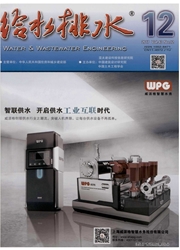

 中文摘要:
中文摘要:
针对环境水体中内分泌干扰物的污染问题,选择邻苯二甲酸二甲酯(DMP)作为典型污染物,以颗粒活性炭、酸化活性炭、粉末活性炭和碳纳米管作为吸附剂,考察吸附剂对DMP的吸附性能和吸附特性。研究结果表明:吸附性碳材料对DMP具有良好的吸附性能,四种碳材料的吸附容量大小为:粉状活性炭〉颗粒活性炭〉酸化活性炭〉碳纳米管。粉末活性炭的单层最大吸附容量为678.3mg/L。Freundlich和Temkin吸附等温线方程能够较好地拟合吸附数据,Langmuir吸附等温线方程对粉末状吸附剂(粉末活性炭、碳纳米管)吸附拟合效果较好。粉末活性炭、颗粒活性炭、酸化活性炭的吸附过程符合一级吸附动力学模型,而碳纳米管吸附过程符合二级吸附动力学模型。
 英文摘要:
英文摘要:
To solve the endocrine disruptor in water environment, the existing endocrine disruptor in water environment-dimethyl phthalate (DMP) was selected as typical endocrine disruptor in this study. Four carbon-based materials, including granular activated carbon, acidified activated carbon, powder acti-vated carbon, and carbon nanotubes, were used as adsorbents to remove DMP in water body. The ad-sorption capacity and characteristics of these four adsorbents were investigated. The results showed that these four carbon-based materials' performances were satisfying. According to their adsorp-tion capacity, these four material were ranked as: powder activated carbon〉granular activated carbon〉acidified activated carbon〉carbon nanotubes. The powder activated carbon had the biggest monolayer adsorp- tion capacity of 678. 3 mg/L. Freundlich and Temkin adsorption imtherm equation could gratefully fit adsorp tion data. Langrnuir could fit the powder adsorbents (powder activated carbon, carbon nanotubes) well. The adsorption process of powder activated carbon, granular activated carbon, and acidified activated carbon fitted in first-order kinetic model, while the adsorption process of carbon nanotubes fitted in second-order kinetic model.
 同期刊论文项目
同期刊论文项目
 同项目期刊论文
同项目期刊论文
 Adsorption of perchlorate from aqueous solution by the calcination product of Mg/(Al–Fe) hydrotalcit
Adsorption of perchlorate from aqueous solution by the calcination product of Mg/(Al–Fe) hydrotalcit Impact of pre-ozonation on disinfection by-product formation and speciation from chlor(am)ination of
Impact of pre-ozonation on disinfection by-product formation and speciation from chlor(am)ination of Characteristics of C-, N-DBPs formation from algal organic matter: Role of molecular weight fraction
Characteristics of C-, N-DBPs formation from algal organic matter: Role of molecular weight fraction Adsorption of perchlorate from aqueous solutions by anion exchange resins: Effects of resin properti
Adsorption of perchlorate from aqueous solutions by anion exchange resins: Effects of resin properti Influence of hydrophobic/hydrophilic fractions of extracellular organic matters of Microcystis aerug
Influence of hydrophobic/hydrophilic fractions of extracellular organic matters of Microcystis aerug Nanoscale iron hydroxide-doped granular activated carbon (Fe-GAC) as a sorbent for perchlorate in wa
Nanoscale iron hydroxide-doped granular activated carbon (Fe-GAC) as a sorbent for perchlorate in wa Photochemical degradation of ciprofloxacin in UV and UV/H2O2 process: kinetics, parameters, and prod
Photochemical degradation of ciprofloxacin in UV and UV/H2O2 process: kinetics, parameters, and prod Removal of Microcystis aeruginosa by potassium ferrate (VI): Impacts on cells integrity, intracellul
Removal of Microcystis aeruginosa by potassium ferrate (VI): Impacts on cells integrity, intracellul Effect of chlorine dioxide on cyanobacterial cell integrity, toxin degradation and disinfection by-p
Effect of chlorine dioxide on cyanobacterial cell integrity, toxin degradation and disinfection by-p Radical induced degradation of acetaminophen with Fe3O4 magnetic nanoparticles as heterogeneous acti
Radical induced degradation of acetaminophen with Fe3O4 magnetic nanoparticles as heterogeneous acti Characterization of algal organic matters of Microcystis aeruginosa: Biodegradability, DBP formation
Characterization of algal organic matters of Microcystis aeruginosa: Biodegradability, DBP formation Removal of perchlorate in water by calcined MgAl-CO3Removal of Perchlorate in Water by CalcinedMgAl-
Removal of perchlorate in water by calcined MgAl-CO3Removal of Perchlorate in Water by CalcinedMgAl- Bacterial reduction of highly concentrated perchlorate: Kinetics andinfluence of co-existing electro
Bacterial reduction of highly concentrated perchlorate: Kinetics andinfluence of co-existing electro Degradation of the antiepileptic drug carbamazepine upon different UV-based advanced oxidation proce
Degradation of the antiepileptic drug carbamazepine upon different UV-based advanced oxidation proce 期刊信息
期刊信息
